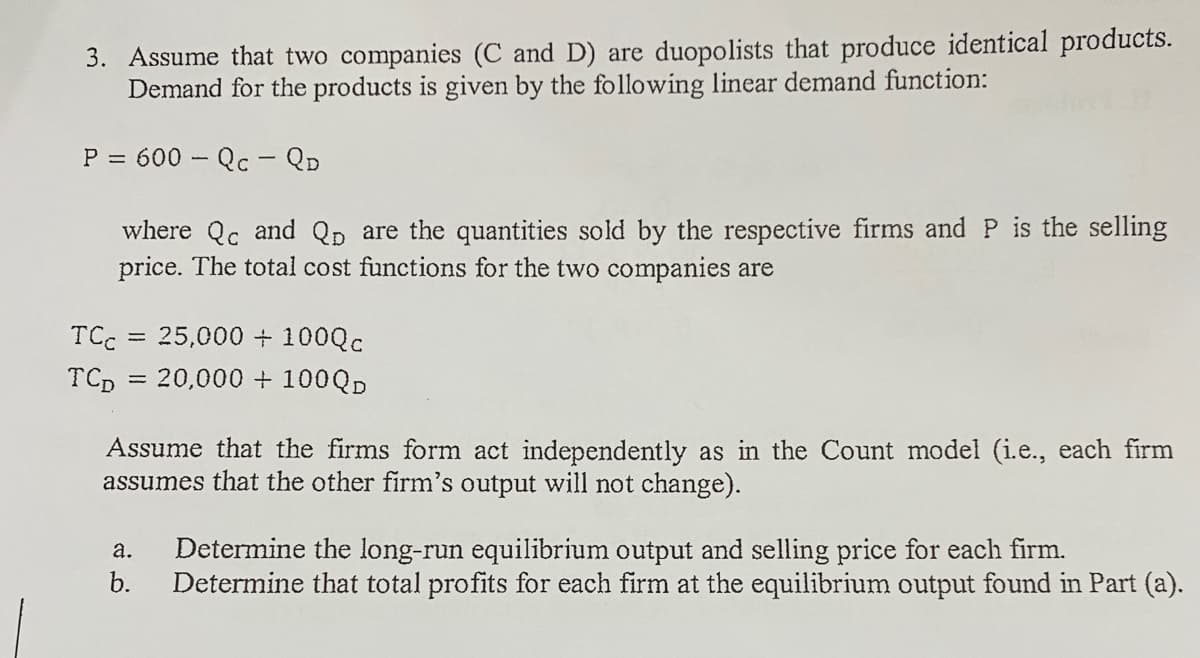3. Assume that two companies (C and D) are duopolists that produce identical products. Demand for the products is given by the following linear demand function: P = 600 – Qc – Q. where Qc and Qp are the quantities sold by the respective firms and P is the selling price. The total cost functions for the two companies are = 25,000 + 100QC = 20,000 + 100QD TCC %3D TCD %3D Assume that the firms form act independently as in the Count model (i.e., each firm assumes that the other firm's output will not change). а. Determine the long-run equilibrium output and selling price for each firm. b. Determine that total profits for each firm at the equilibrium output found in Part (a).
3. Assume that two companies (C and D) are duopolists that produce identical products. Demand for the products is given by the following linear demand function: P = 600 – Qc – Q. where Qc and Qp are the quantities sold by the respective firms and P is the selling price. The total cost functions for the two companies are = 25,000 + 100QC = 20,000 + 100QD TCC %3D TCD %3D Assume that the firms form act independently as in the Count model (i.e., each firm assumes that the other firm's output will not change). а. Determine the long-run equilibrium output and selling price for each firm. b. Determine that total profits for each firm at the equilibrium output found in Part (a).
Managerial Economics: Applications, Strategies and Tactics (MindTap Course List)
14th Edition
ISBN:9781305506381
Author:James R. McGuigan, R. Charles Moyer, Frederick H.deB. Harris
Publisher:James R. McGuigan, R. Charles Moyer, Frederick H.deB. Harris
Chapter12: Price And Output Determination: Oligopoly
Section: Chapter Questions
Problem 1E
Related questions
Question
Please

Transcribed Image Text:3. Assume that two companies (C and D) are duopolists that produce identical products.
Demand for the products is given by the following linear demand function:
P = 600 – Qc - QD
where Qc and Qp are the quantities sold by the respective firms and P is the selling
price. The total cost functions for the two companies are
TCC
25,000 + 100Qc
%3D
TCp = 20,000 + 100QD
Assume that the firms form act independently as in the Count model (i.e., each firm
assumes that the other firm's output will not change).
а.
Determine the long-run equilibrium output and selling price for each firm.
b.
Determine that total profits for each firm at the equilibrium output found in Part (a).
Expert Solution
This question has been solved!
Explore an expertly crafted, step-by-step solution for a thorough understanding of key concepts.
This is a popular solution!
Trending now
This is a popular solution!
Step by step
Solved in 2 steps

Knowledge Booster
Learn more about
Need a deep-dive on the concept behind this application? Look no further. Learn more about this topic, economics and related others by exploring similar questions and additional content below.Recommended textbooks for you

Managerial Economics: Applications, Strategies an…
Economics
ISBN:
9781305506381
Author:
James R. McGuigan, R. Charles Moyer, Frederick H.deB. Harris
Publisher:
Cengage Learning


Principles of Economics 2e
Economics
ISBN:
9781947172364
Author:
Steven A. Greenlaw; David Shapiro
Publisher:
OpenStax

Managerial Economics: Applications, Strategies an…
Economics
ISBN:
9781305506381
Author:
James R. McGuigan, R. Charles Moyer, Frederick H.deB. Harris
Publisher:
Cengage Learning


Principles of Economics 2e
Economics
ISBN:
9781947172364
Author:
Steven A. Greenlaw; David Shapiro
Publisher:
OpenStax

Principles of Microeconomics
Economics
ISBN:
9781305156050
Author:
N. Gregory Mankiw
Publisher:
Cengage Learning

Economics: Private and Public Choice (MindTap Cou…
Economics
ISBN:
9781305506725
Author:
James D. Gwartney, Richard L. Stroup, Russell S. Sobel, David A. Macpherson
Publisher:
Cengage Learning

Microeconomics: Private and Public Choice (MindTa…
Economics
ISBN:
9781305506893
Author:
James D. Gwartney, Richard L. Stroup, Russell S. Sobel, David A. Macpherson
Publisher:
Cengage Learning